
The Chola dynasty was one of the longest-ruling dynasties in history. The earliest datable references to this Tamil dynasty are in inscriptions from the 3rd century BCE left by Ashoka, of the Maurya Empire. As one of the Three Crowned Kings of Tamilakam, the dynasty continued to govern over varying territory until the 13th century CE.
Athirajendra Chola reigned for a very short period of few months as the Chola king succeeding his father Virarajendra Chola. His reign was marked by civil unrest, possibly religious in nature, in which he was killed. The Chalukya Chola prince Rajiga succeeded him as Kulothunga Chola I.
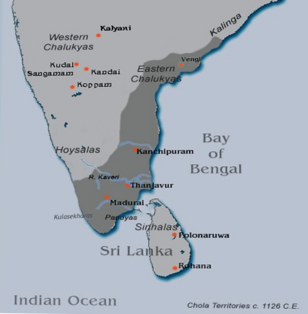
Kōpparakēsarivarman Vikrama Chola was a 12th-century king of the Chola empire. He succeeded his father Kulothunga Chola I to the throne in 1120 CE. An inscription of his from Sidlaghatta in Karnataka mentions the Saka date 1042. Another from the same location also mentions the Saka date and also gives him the title Rajaraja.
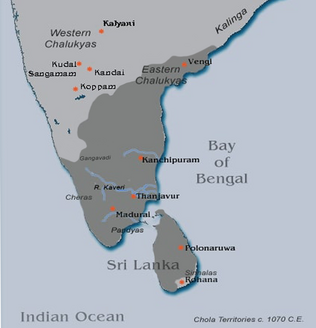
The Later Chola dynasty ruled the Chola Empire from 1070 C.E. until the demise of the empire in 1279 C. E. This dynasty was the product of decades of alliances based on marriages between the Cholas and the Eastern Chalukyas based in Vengi and produced some of the greatest Chola emperors such as Kulothunga Chola I.
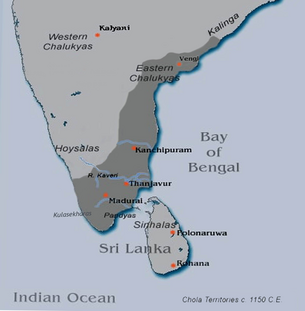
Kulothunga Chola II was a 12th-century king of the Chola Dynasty of the Tamil people of South India. He succeeded his father Vikrama Chola to the throne in 1135 CE. Vikrama Chola made Kulothunga his heir apparent and coregent in 1133 CE, so the inscriptions of Kulothunga II count his reign from 1133 CE. Kulothunga II's reign was a period of general peace and good governance.

Rajadhiraja Chola II reigned as the Chola king succeeding Rajaraja Chola II. Rajaraja Chola II chose Rajadhiraja II, a grandson of Vikrama Chola as his heir in 1166 as he did not have any sons of his own who were old enough to ascend the throne.

Kulothunga Chola III also known as aChakravarti was the ruler of the Chola empire from 1178 to 1218 CE, after succeeding Rajadhiraja Chola II. Kulothunga Chola III gained success in war against his traditional foes. He gained victories in war against the Hoysalas, Pandyas of Madurai, Cheras of Venad, the Sinhala kings of Eelam (Ceylon), as well as the Chodas of Velanadu and Nellore. He also restored Chola control over Karur, which were ruled by the Adigaman chiefs as vassals of the Cholas. He drove out the Hoysalas under Veera Ballala II who had made inroads in the Gangavadi and adjoining areas of Tagadur in Kongu country in an effort expand their territory. However, during the last two years of his reign, he lost in war to the resurgent Pandyas, heralded a period of steady decline and ultimately, demise of the Cholas by 1280 CE.

Rajaraja Chola III succeeded Kulothunga Chola III on the Chola throne in July 1216 CE. Rajaraja came to the throne of a kingdom much reduced in size as well as influence. With the rise of the Pandya power in the south, the Cholas had lost most of their control of the territories south of the river Kaveri and their hold on the Vengi territories in the north was slipping with the emergence of the Hoysala power.
Chola literature, written in Tamil, is the literature created during the period of Chola reign in South India between the 9th and the 13th centuries CE. The age of the imperial Cholas was the most creative epoch of the history of South India and was the Golden Age of Tamil culture.

Sendamangalam is a Taluk in the Indian state of Tamil Nadu is situated in Namakkal District.

Thungapuram is a panchayat village of Perambalur district, Tamil Nadu, India. It was formerly in Tiruchirappalli district

Thyagaraja Temple is a Shiva temple, located in the town of Thiruvarur in Tamil Nadu, India. Shiva is worshiped as Moolanathar, and is represented by the lingam. Daily poojas are offered to his idol referred to as Maragatha lingam. His consort Parvathi is depicted as Kondi. The presiding deity is revered in the 7th century Saiva canonical work, the Tevaram, written in Tamil by saint poets known as the nayanars and classified as Paadal Petra Sthalam.
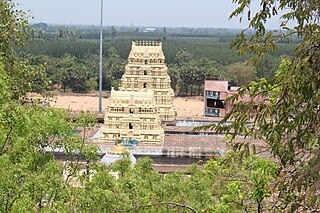
Devanathaswamy temple in Thiruvanthipuram, a village in the outskirts of Cuddalore in the South Indian state of Tamil Nadu, is dedicated to the Hindu god Vishnu. Constructed in the Dravidian style of architecture, the temple is glorified in the Divya Prabandha, the early medieval Tamil canon of the Azhwar saints from the 6th–9th centuries AD. It is one of the 108 Divyadesam dedicated to Vishnu, who is worshipped as Devanathaswamy and his consort Lakshmi as Hemabhujavalli.

The period of Chola rule in the island of Sri Lanka began with the invasion in 993 AD, when Raja Raja Chola sent a large Chola army which conquered the Anuradhapura Kingdom, in the north, and added it to the Chola Empire. Most of the island was subsequently conquered and incorporated as a province of the vast Chola empire during the reign of his son Rajendra Chola.

Ennayiram is a village in Vikravandi taluk in Villuppuram district in the Indian state of Tamil Nadu. The major occupation of the people living at this place is agriculture.
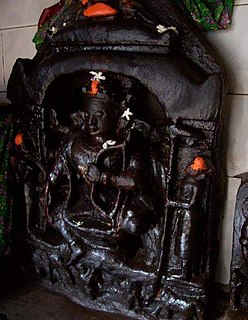
Anantavarman Chodaganga was a ruler of the Eastern Ganga dynasty which ruled the southern part of Kalinga, India. He was the son of Rajaraja Devendravarman and Rajasundari, the daughter of Virarajendra Chola. The Chola king Kulothunga Chola I of the Chola dynasty was his uncle. However, historian S.N. Sen states that Anantavarman was the maternal grandson of Kulottunga. The Jagannath Temple at Puri was rebuilt in the 11th century atop its ruins by Anantavarman Chodaganga.

The Vaikunta Perumal Temple in Uthiramerur, a village in the South Indian state of Tamil Nadu, is dedicated to the Hindu god Vishnu. The temple is constructed in the Dravidian style of architecture. Vishnu is worshipped as Vaikunta Perumal and his consort Lakshmi as Anandavalli. The temple was originally built by Pallavan, with later additions from the Chola. The temple is known for the inscriptions indicating the democratic practises of electing representatives for the village bodies during the regime of Parantaka Chola.

Vaseeswarar Temple is a Hindu temple dedicated to the deity Shiva, located in Thirupasoor, a village in Tiruvallur district in the South Indian state of Tamil Nadu. Shiva is worshiped as Vaseeswarar, and is represented by the lingam. His consort Parvati is depicted as Pasupathinayagi. The temple is located on the Southern banks of Poondi reservoir on the Thiruvallur - Thiruthani road, 5 km (3.1 mi) away from the town. The presiding deity is revered in the 7th century Tamil Saiva canonical work, the Tevaram, written by Tamil saint poets known as the nayanmars and classified as Paadal Petra Sthalam.
























